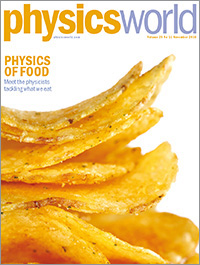By Matin Durrani
If you love crisps – and frankly who doesn’t? – you’ll relish the cover feature of the latest issue of Physics World, in which features editor Louise Mayor tours the world’s biggest crisp factory at Leicester in the UK to see how physics is improving production of this yummy salty snack. The issue is now live in the Physics World app for mobile and desktop and will also be made available on physicsworld.com later this month.
Elsewhere in this special issue on physics and food, you can find out how electric fields could help to cut the fact from chocolate and discover why sound holds the key to our appreciation of what we eat.
You can also see how physicists – being masters of data-gathering, modelling and simulation – are ideally placed to develop products that are healthier, more nutritious and make more of our resources. Find out too how soft-matter physicists are crafting “functional” foods that promote feelings of fullness and satisfaction.
If you’re a member of the Institute of Physics (IOP), you can now enjoy immediate access to the new issue with the digital edition of the magazine in your web browser or on any iOS or Android mobile device (just download the Physics World app from the App Store or Google Play). If you’re not yet in the IOP, you can join as an IOPimember for just £15, €20 or $25 a year to get full access to Physics World digital.
 For the record, here’s a run-down of what else is in the issue.
For the record, here’s a run-down of what else is in the issue.
• Nobel prize for toplogical pioneers – David Thouless, Duncan Haldane and Michael Kosterlitz share the 2016 Nobel Prize for Physics for their work on topological phase transitions, as Tushna Commissariat reports
• Brewing coffee – There’s far more physics to a humble espresso machine than meets the eye, as Robert P Crease finds out
• Why physics and food? – Peter Lillford describes challenges facing the food industry that require a physics approach, from the characterization of foods to their modelling and simulation
• Hungry for solutions – As obesity rates continue to rise in many parts of the world, Cait MacPhee explains how soft-matter physicists could help reverse the trend by crafting “functional” foods that promote feelings of fullness and satisfaction
• Shocking chocolate into shape – Wouldn’t you love chocolate to have less fat but all the taste? Stephen Ornes discovers how the study of electrorheological fluids has led one physicist to a develop a new way to trim the fat from chocolate
• The journey of a crisp – Louise Mayor tours to the world’s biggest crisp factory to find out how physicists are fine-tuning the transformation of potatoes into our favourite salty snack
• Make it snappy – From chocolate and cookies to crisps and celery, Philip Ball explores the roles of sound and feel in our appreciation of food
• How weather became a science – David M Schultz reviews Inventing Atmospheric Science: Bjerknes, Rossby, Wexler, and the Foundations of Modern Meteorology by James Rodger Fleming
• Is the universe a sponge? – Martin Bucher reviews The Cosmic Web: Mysterious Architecture of the Universe by J Richard Gott
• Final destination: space – Frances Wray describes how she turned childhood dreams
about travelling to Mars into a career designing and testing components for space missions
• Once a physicst: Juliet Davenport – meet the founder and chief executive of Good Energy, a UK-based supplier and generator of renewable energy
• It’s all about energy – Paul R Bowden thinks about energy
Guidelines
Show/hide formatting guidelines
this text was deletedwhere people live in harmony with nature and animals</q>
Some text